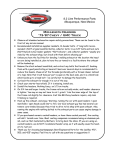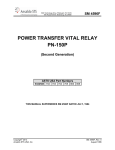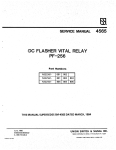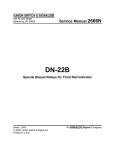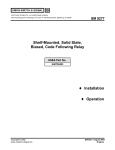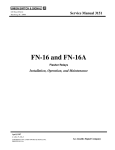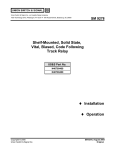Download Instructions for Cleaning Relay Contacts
Transcript
Service Manual 645 Russell Street Batesburg, SC 29006 4560 Instructions for Cleaning Relay Contacts September, 1999 © 1999, Union Switch & Signal Inc. Printed in the U.S.A. An Ansaldo Signal Company REVISION HISTORY January, 1961 January, 1997 September, 1999 SM 4560 (9/99) 1 Cleaning Relay Contacts This service manual covers recommended methods for the preparation and cleaning of relay contacts on all shelf relays and plug-in type safety relays. 1.0 RECOMMENDED CLEANING MATERIALS Burnishing Tool, T.K. Neuses Co. No. 3-316 ................................................J397187 Burnishing Tool, P.K. Neuses Co. No. N318 (Heavy Duty)....................J397187-001 Paper Strip, strips cut from 67 pound white Springhill Vellum Bristol Paper .J793094 Also recommended (commercially available): Emery Paper (Wet or Dry): 600 Grit, cut in strips Alcohol #1 Solvent (Ethyl Alcohol Proprietary 190 or equivalent) Note When using the paper strip, clean the back contacts first and the front contacts last. Discard the paper strips when dirty. 2.0 CONTACT CLEANING PROCEDURE 2.1 Contacts that are severely burned: a. Using 600 grit emery paper strip, folded with the grit side out so that both contacts can be burnished simultaneously, stroke the contacts in the direction of the contact wipe. b. Using the burnishing tool, stroke the contacts several times in the direction of contact wipe. c. Place the paper strip between the open contacts, then close the contacts and withdraw the paper strip. d. Repeat step “c” several times, if necessary. e. Using the alcohol spray, give the contacts a degreasing/wash. f. Place the paper strip between the open contacts, then close the contacts and withdraw the paper strip. g. Repeat step “f” several times, if necessary. 2.2 Contacts with heavy tarnish, slightly rough, or pitted surface: a. Perform the procedure in Section 2.1, steps “b” through “g.” 2.3 Contacts with surface film or oxidation (not pitted): a. Perform the procedure in Section 2.1, steps “f” and “g.” 2 SM 4560 (9/99) Cleaning Relay Contacts 3.0 SPECIAL HANDLING OF CONTACTS FOR SHELF-TYPE SAFETY RELAYS 3.1 Recommended materials: Burnishing Tool, P.K. Neuses Co. (Heavy Duty) .............................J397187-001 Also recommended (commercially available): Round Rubber Pencil Eraser, ¼ to 5/16” (for use in drill press) Flat Rubber Hand-Held Eraser Alcohol #1 Solution (Ethyl Alcohol Proprietary 190, or equivalent) 3.2 Preparation of replacement or worn contacts: a. Flat Silver Tips Silver tips should be carefully prepared before contacts are adjusted. Best service is obtained from a contact surface polished as highly as possible. Care should be taken to avoid the coarse finish resulting from ordinary fine files. Silver tips that have become burned or pitted from excessive loading or an accidental short through the contacts should be smoothed with the burnishing tool, unless burned or pitted, or pitted enough to require replacement. The burnishing should be done in a direction corresponding to the direction of the slide of the contact. The use of erasers is recommended for the final polishing. The round eraser is for use in a drill press, the end of the eraser being rotated over the silver surface. The rotating eraser should touch the silver lightly and should not be held in one place too long, because this tends to overheat the silver contact. The flat eraser is a hand eraser, also used for polishing by stroking the silver in the direction of the contact slide. In all cases, the silver should be against solid backing, so it does not become twisted to cause beveling of the surfaces. Care should be taken to remove all eraser particles after polishing. b. Silver Impregnated Carbon Contacts The sharp tips of new carbons (DN-11 wedge-type only) should be broken slightly by burnishing in a plane parallel to the springs. The burnishing tool should be used for this operation. This burnishing should produce a smooth surface having no undercuts caused by the edge of the tool. After burnishing has been completed, all loose particles should be removed with a camel’s hair brush, followed by a spray of alcohol. 3.3 Final cleaning of contacts for shelf-type safety relays Final cleaning of contacts can be performed as described in Section 2.0. SM 4560 (9/99) 3 Cleaning Relay Contacts 4.0 ORDERING INFORMATION A relay contact cleaning kit (part number X451646-0901) contains one each of the following: Burnishing Tool Burnishing Tool (Heavy Duty) Paper Cleaning Kit (50 strips, 5/8” x 7-1/2”) J397187 J397187-001 J793094 Individual items from the kit are also available when ordering the above item’s individual part number. 4 SM 4560 (9/99)





